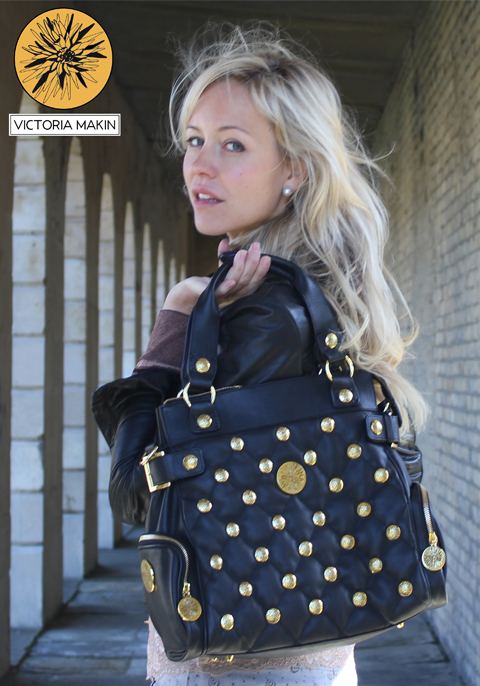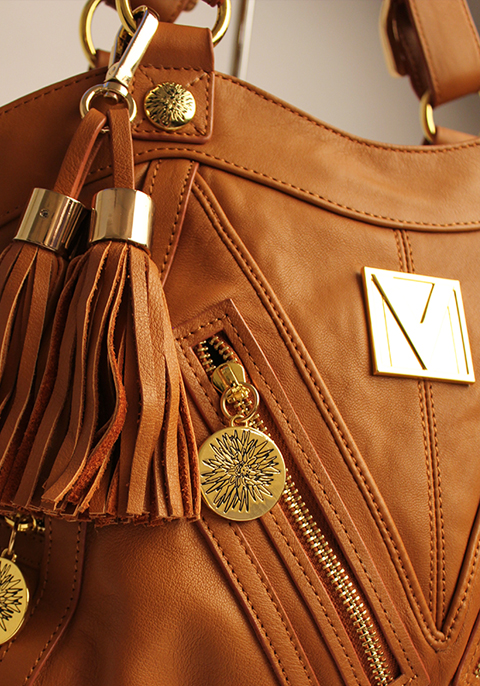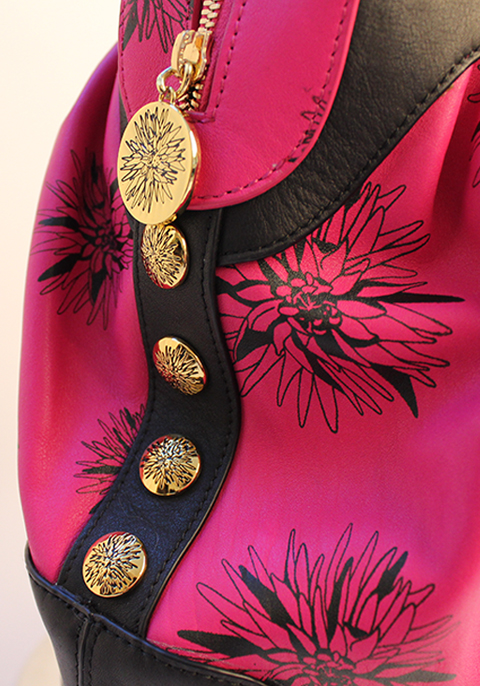


Victoria Makin is receiving us at her studio in London. Overlooking Chelsea’s village-like surroundings, her atelier is a tribute to her artistic heritage: drawings and leather swatches are scattered across a busy study, bag samples are lined up and diffuse a smell of fine leather, walls exhibit works from some of her favorite artists, such as Henri Rousseau, Gustav Klimt or contemporary fellow Yorkshireman David Hockney. As the interview gets started, we are treated with the finest (Yorkshire) tea and biscuits:
Good morning Victoria and thank you for inviting us in. Starting at the beginning, how early did you develop a passion for fashion and accessories? When did you realize that you had such a talent for it?
I was fortunate to be born and raised in the Yorkshire Dales, with its beautiful scenic landscape and its rich flora. My mother was a florist and I became adept at drawing and painting flowers from a young age. A pencil and paper in hand, a bunch of flowers on the table, and the imagination of a young girl would run wild…
I started combining my creative side with fashion as a teenager. At 14, I was scouted by a model agency and I appeared in a number of campaigns, visiting London’s fashion district, the catwalks, photo-shoots, etc.
While I enjoyed modeling, I thought my calling was more on the creative end. I followed a foundation course in Art in York, before enrolling for a BA degree in Fashion design at the university of Northumbria, where I specialized in printed textiles.
Where did you learn the trade? Who did you work with before launching yourself?
I graduated at the London Fashion Week in 2004, where Hilary Alexander was part of the judging panel and during which my collection was noticed by the editors of Elle magazine. I then went on to work for some of the UK’s leading fashion brands, where I designed not only handbags but also jewellery and other textile accessories such as scarfs and prints.
This was very rewarding in itself, particularly the fact that many of my designs became best sellers and I would often randomly bump into people carrying my designs in the street.
What pushed you to create your own label? What makes you stand apart from the fashion establishment?
Over the years, I have been spoiled enough to wear many luxury accessories from most high-end brands. As a customer and fashion enthusiast, I grew sometimes frustrated by paying vast amount of money for accessories and handbags, whose quality and exclusivity would not necessarily live up to their price tag.
I feel too many women buy brand names out of safety but this is a recipe for disappointment as everybody ends up wearing the same shapes, colors, etc. I mean, where is the exclusivity of spending £1,000 on a canvas bag with a plain logo when it is produced by the thousand and copied by the million?
This is where my brand fits in, I believe. My collection comprises of exclusive handbags displaying the finest materials, unique details, with an intelligent pricing and in small orders.
Can you tell us more about your manufacturing?
I personally source the leather and metals in Italy. Besides, I collaborate on the manufacturing with some excellent craftsmen in Spain, where ‘maroquinerie’ has been a family trade for generations.
All handbags carry unique details, which I create through hand drawings and computer enhancements. Such details are engineered into the fabric through embossing, printing or quilting.
All bags are very practical for a modern day-to-day life with plenty of pockets. We also offer bespoke orders should the customer wish for specific colors or her name engraved for instance.
Where do you design? How do you find inspiration?
My studio here is my main work place but often time I feel the need to escape London to concentrate. As for inspiration, I remember what writer Ray Bradbury used to say on this topic: “First, find out what your hero wants. Then just follow him”. My heroine is a modern, educated, glamorous, emancipated woman who wants her appearance to project her values to the outside world and feel beautiful and desirable.
Your signature trademark on all your handbags is the Dahlia flower. What made you choose this flower, what does it represent?
To this day, I remain mesmerized by the symbolic power of flowers, their addictive scent and extrovert sensuality…I cannot imagine dealing with fashion without flowers, they are second nature to all of us.
So many artists have celebrated the rose that I wanted to travel elsewhere. The Dahlia is a magnificent under-study to the rose and illustrious poets (such as Paul Verlaine or Joseph Breck) were no strangers to its special appeal. The flower carries a sense of independence and understated elegance, which are traits I associate with my heroines. “The queen dressed in splendor” as Verlaine put it…
I also love the dahlia for historical reasons. The flower first appeared in South America and it was not until 1804 that Lady Holland imported it to the UK. She sent seeds to Holland House (Kensington, London), where the plants were successfully raised.
Lady Holland was also a famous socialite and a political and literary hostess; arguably one could call her an early feminist before such concept was made popular. This ties well with other characters of our brand, mainly its noble British heritage, its London-Chelsea roots and how fashion should stand up for women.
Your bags have a broad appeal but do you have a specific woman in mind for your designs?
I often get this question and the truth is I probably don’t want to narrow my artistic journey by focusing only on a specific age group or even a specific ethnicity or social belonging. Fashion can overcome such fragmentation.
My ultimate priority is to design bags I am proud to wear, which make me feel confident and beautiful. I aim at helping women assert and carry forward their sense of sophistication, elegance and desirability.
What are other major influences in your work?
I am a great nostalgic of the first half of the twentieth century, namely the 1920s to 1940’s. The period was extraordinary in many respects; the world went through so many upheavals, high and lows. Yet despite two destructive wars, fashion witnessed some its most creative minds and muses.
Do you have somebody in mind that you truly want to wear your bags? Who would be your ultimate fashion muse?
Among classic muses, women like Audrey Hepburn or Greta Garbo, who were so elegant and feminine. Grace Kelly as well in her fairytale wedding.
Among modern day muses, I would love Eva Green to wear my bags in her role as Vesper Lynd in Casino Royale. I also love the work of Vivienne Westwood and Diane von Furstenberg, truly inspiring.


